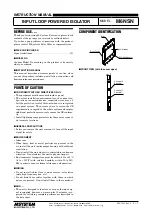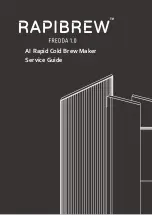
13
Inspection & Maintenance
ATEX
This product has been designed for use in
explosive atmospheres in line with the following
requirements and information. Any use which
differs or exceeds this is considered incorrect
and REID Lifting Ltd will not accept any
responsibility or liability for damages resulting
from false application. The risk is solely with the
user. If the product has been customized in
any way, then it may not comply with standards
and no longer be suitable for use in explosive
atmospheres. If this is the case, then the product
will not have any of the markings below. If in
doubt, please contact your REID representative.
Classification [Zone 2]
As standard, the product meets the requirements
of Category 3 equipment for use in Zone 2
explosive atmospheres, providing a normal level
of protection where mixtures of air and gases,
vapors or mists or by air and dusts mixtures are
unlikely to occur or, if they do occur, are likely
to do so only infrequently and for a short period
only.
The product will have the following identification
on the serial label:
Spark Formation
There is an Increased danger of ignition when
certain material pairings clash, namely non-
corrosion-resistant steel or cast iron against
aluminum, magnesium or pertinent alloys. This
applies especially in the case of rust or surface
rust. When assembling the product and inserting
fastening components, these must therefore be
clear of rust and debris of any kind. As stated
previously, care must be taken to ensure the
gantry is handled in a suitable manner, never
thrown down and always placed carefully onto
the ground.
For Zone 2 applications, the height of the
product should not be adjusted using the
ratchet mechanism and/or geared wheel
within those zones.
REID recommends the use of corrosion
resistant tools when assembling the product
to prevent the possibility of any sparks.
PORTA
GANTRY
11000
The following information is based on REID
Lifting’s recommendations and does not remove
the responsibility of the user to comply with the
relevant regulations and standards that are valid
in the respective countries and regions where the
system is being used.
Regular Inspections
To ensure that the product’s frame remains in safe
working order it must be inspected regularly by a
competent or qualified person. We recommend
inspections every 6 months for personnel lifting
and every 12 months for goods only, unless
local regulations, adverse working conditions or
profile of use and risk dictate shorter periods. The
components of the system need to be checked
for damage, wear, corrosion or other irregularities.
It may be necessary to disassemble the system
in order to do this. Particular attention should be
paid to checking the profiles for denting, pins and
fixings for integrity, making sure there is no wear
or elongation on the bolt holes and ensuring that
the trolley moves freely along the beam.
It is recommended that once inspected or
repaired, the device is marked with the date of
the next inspection.
Inspections are instigated by the user. If detailed
information is required on inspection and test
criteria, please contact your supplier’s technical
department or REID Lifting.
The equipment Inspection Record is on page 35.
If using the product in explosive atmospheres, see
additional section titled ATEX.
Maintenance & Repair
In order to ensure correct operation, the
conditions for inspection and maintenance must
be complied with. If any defects are found, stop
using the product immediately.
No alterations or additions to the equipment
beyond the replacement of standard parts by
an authorized representative should be made
without the written consent of the manufacturer.
Any necessary repairs identified during
inspections should only be carried out by an
approved specialist workshop using original
spare parts. Any repair must be carried out in
accordance with the manufacturer’s instructions.
It is recommended to maintain the equipment in
a clean and dry manner. Cleaning is suggested
using a sponge or cloth with warm, soapy water,
rinsing and allowing to dry.
This product must be assembled using metric
fixings of the same type and quality as those
supplied by the original manufacturer only.
Failure to do so could have an impact on the
structural performance and stability of the
product. REID Lifting and its resellers can supply
these spare parts locally.
Storage & Transportation
When transporting the components, take note of
all the manual handling considerations.
Do not throw the product down or stack any
items on top of it.
Always place carefully and securely on the
ground to avoid damaging the equipment.
ATEX
As Standard for Zone 2 Environments:
II 3 GD
Ex h IIC T6 Gc
Ex h IIIC T85°C Dc
Tamb -20°C to +55°C
II – Equipment Group
2/3 – Atex Category
GD – Gas & dust
h- non- electrical protection concept
IIC / IIIC – IEC equipment group
T6 / T85°C – temperature classification
Gc /Gb – equipment protection level (gas)
Dc/Db – equipment protection level (dust)
Tamb – ambient temperature range







































